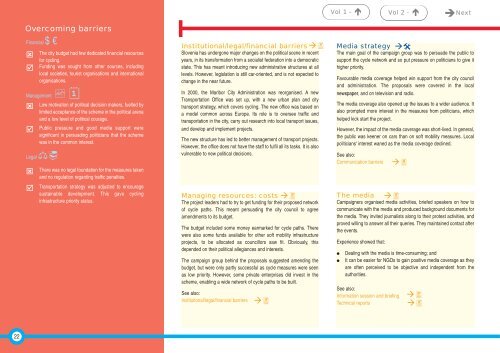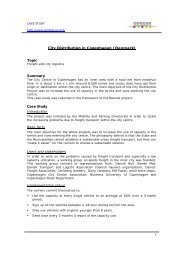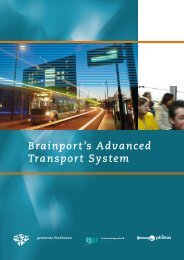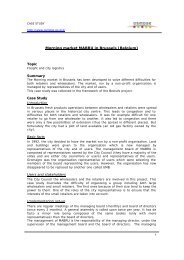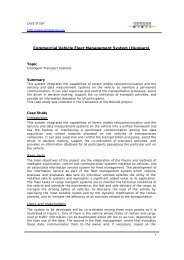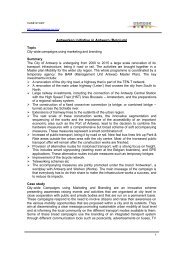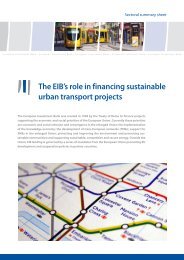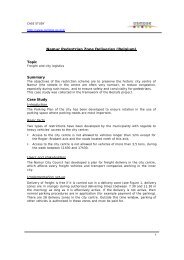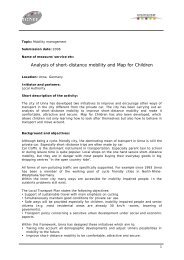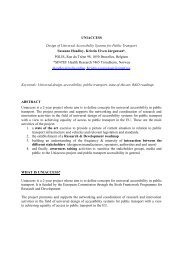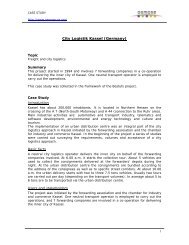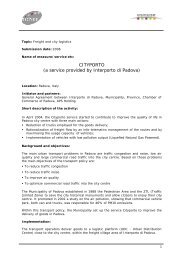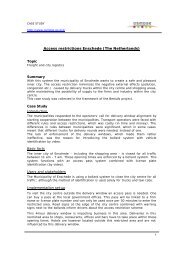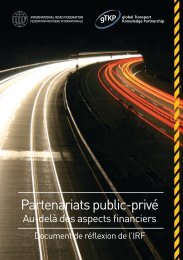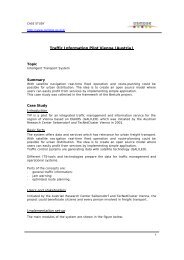Successful transport decision-making - Osmose
Successful transport decision-making - Osmose
Successful transport decision-making - Osmose
You also want an ePaper? Increase the reach of your titles
YUMPU automatically turns print PDFs into web optimized ePapers that Google loves.
Overcoming barriers<br />
Financial $ €<br />
<br />
<br />
The city budget had few dedicated financial resources<br />
for cycling.<br />
Funding was sought from other sources, including<br />
local societies, tourist organisations and international<br />
organisations.<br />
Management <br />
<br />
Low motivation of political <strong>decision</strong> makers, fuelled by<br />
limited acceptance of the scheme in the political arena<br />
and a low level of political courage.<br />
<br />
Public pressure and good media support were<br />
significant in persuading politicians that the scheme<br />
was in the common interest.<br />
Legal <br />
<br />
<br />
There was no legal foundation for the measures taken<br />
and no regulation regarding traffic penalties.<br />
Transportation strategy was adjusted to encourage<br />
sustainable development. This gave cycling<br />
infrastructure priority status.<br />
Institutional/legal/financial barriers<br />
Slovenia has undergone major changes on the political scene in recent<br />
years, in its transformation from a socialist federation into a democratic<br />
state. This has meant introducing new administrative structures at all<br />
levels. However, legislation is still car-oriented, and is not expected to<br />
change in the near future.<br />
In 2000, the Maribor City Administration was reorganised. A new<br />
Transportation Office was set up, with a new urban plan and city<br />
<strong>transport</strong> strategy, which covers cycling. The new office was based on<br />
a model common across Europe. Its role is to oversee traffic and<br />
<strong>transport</strong>ation in the city, carry out research into local <strong>transport</strong> issues,<br />
and develop and implement projects.<br />
The new structure has led to better management of <strong>transport</strong> projects.<br />
However, the office does not have the staff to fulfil all its tasks. It is also<br />
vulnerable to new political <strong>decision</strong>s.<br />
Managing resources: costs<br />
The project leaders had to try to get funding for their proposed network<br />
of cycle paths. This meant persuading the city council to agree<br />
amendments to its budget.<br />
The budget included some money earmarked for cycle paths. There<br />
were also some funds available for other soft mobility infrastructure<br />
projects, to be allocated as councillors saw fit. Obviously, this<br />
depended on their political allegiances and interests.<br />
The campaign group behind the proposals suggested amending the<br />
budget, but were only partly successful as cycle measures were seen<br />
as low priority. However, some private enterprises did invest in the<br />
scheme, enabling a wide network of cycle paths to be built.<br />
See also:<br />
Institutional/legal/financial barriers<br />
<br />
<br />
<br />
Vol 1 - <br />
Media strategy<br />
The main goal of the campaign group was to persuade the public to<br />
support the cycle network and so put pressure on politicians to give it<br />
higher priority.<br />
Favourable media coverage helped win support from the city council<br />
and administration. The proposals were covered in the local<br />
newspaper, and on television and radio.<br />
The media coverage also opened up the issues to a wider audience. It<br />
also prompted more interest in the measures from politicians, which<br />
helped kick start the project.<br />
However, the impact of the media coverage was short-lived. In general,<br />
the public was keener on cars than on soft mobility measures. Local<br />
politicians' interest waned as the media coverage declined.<br />
See also:<br />
Communication barriers<br />
The media<br />
Campaigners organised media activities, briefed speakers on how to<br />
communicate with the media and produced background documents for<br />
the media. They invited journalists along to their protest activities, and<br />
proved willing to answer all their queries. They maintained contact after<br />
the events.<br />
Experience showed that:<br />
<br />
<br />
<br />
Dealing with the media is time-consuming; and<br />
It can be easier for NGOs to gain positive media coverage as they<br />
are often perceived to be objective and independent from the<br />
authorities.<br />
See also:<br />
Information session and briefing<br />
Technical reports<br />
Vol 2 - <br />
<br />
<br />
<br />
<br />
Next<br />
22


